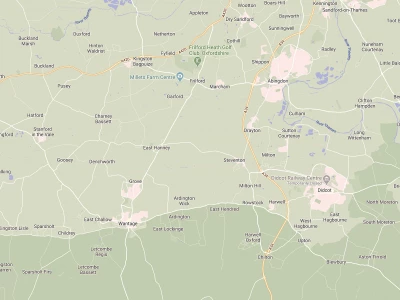Wantage Workhouse
Wantage Workhouse
By Libby Hawkness-Smith, read by James Kent
Much of this text was written using the book 'Gallon Loaves and Fustian Frocks' by Hazel Brown
The track can be heard here: Wantage Workhouse
More information on the workhouse in Wantage can be found here: Wantage workhouse
The text is as follows:
Hi, my name is James and I'd like to tell you a bit about Wantage workhouse.
Since Elizabethan times in the 1500s, parish areas have been responsible for caring for their poor. This became increasingly more difficult to do in the south of England in the 1800s, as many were agricultural workers and farming was the main occupation. Food prices were high, agricultural wages were low, and the onus on the rich to support a growing number of poor became unsustainable at the time.
Unemployment was also particularly high as there wasn't any work once harvest had come and the corn had been threshed; there was also less work to be done in the autumn with the invention and use of threshing machines. In other places, women and children could earn additional wages through lace making, glove making, straw plaiting, straw hat making, and other home industries but this didn't exist in Wantage.
In 1834, the Poor Law Amendment Act was made to standardise provision for the poor nationally, and to create workhouses for those who had no other means of income. The conditions in workhouses were to be worse than those experienced by labourers in the community. Parishes were still to pay the subsistence costs for the poor, but the amount paid to the paupers (the very poor) would be decided by each union. From 1865, each union became responsible for all the paupers in their area rather than the onus falling to individual parishes. This was to standardise the amount of money that each pauper would receive rather than it being so much of a early postcode lottery.
Before 1834, most relief helped people to survive in their homes, but the 1834 Act insisted that no able-bodied male pauper or his family were to be given enough relief for this to happen unless in exceptional cases of sickness or accident. If he was fit and well but out of work or not managing on his wages, the only help he and his family could receive was through a workhouse.
The Wantage union, which was declared on 19th March 1835, was one of the earliest nationally. The Wantage union was the second largest in Berkshire. It had the second largest number of parishes but the sixth in terms of the population covered. Tanning had provided work in earlier times but had ceased by 1835.
One of the first things the union did was to organise the setting up of a workhouse. There was already a workhouse in Wantage a mile and a half from the market square, to the south of Wantage, on the Hungerford Road, that could accommodate 120 paupers, and it was decided to enlarge this to accommodate a maximum of 350 paupers. In the 1840s, the workhouse was near capacity; at other times, it was rare for there to be more than 100 inmates.
Workhouses, including Wantage, generally had their own water supply and means of sewerage disposal, but this wasn't without its problems. Only the living quarters were heated, not the bedrooms, as was common with many poorer houses at the time. A coal-fired boiler supplied the hot water for the heating. Five months into the operation, doors were requested for the children's toilets! Until then, they had been open to the yard.
Before 1834, some parishes had cottages that belonged to the parish and could be let at a low rent or provided free to the poor of the parish. In 1834, these were deemed to be an asset which could be sold to help fund the parish contribution to the workhouse building. East Ilsley sold four cottages, and Childrey told the tenants of their three cottages that they needed to vacate or start paying rent.
The conditions in a workhouse were designed to be worse than the conditions at home for the inmates in order to dissuade them from wanting to be in a workhouse. Inmates led regulated, boring lives, and were divided by age, sex and health. Families were separated except for children under 7, whose mothers, in theory, had access to them at all times.
Babies stayed with their mothers while they were weaned. Under 7s were looked after by older women while their mothers worked. Parents were allowed to see older children once a day, but there were no minimum times given for visits. Most people slept in communal dormitories though three older couples are recorded as having lived together in their own room.
To be taken into a workhouse, a person had to have an order (or provisional order) from the overseer or church warden of their parish, or master of the workhouse. Some people walked 10 miles to try to secure a place but were not always successful. On being admitted to a workhouse, a person was checked by a medical officer and assigned to the most appropriate available ward, given a bath, had their own clothes removed and fumigated (to be returned when they left), and given a workhouse uniform.
Rooms were bare, dining benches were backless, and sleeping quarters were unavailable from 5am to 8pm. Work was tedious and mainly comprised grinding flour, sack making, unravelling old rope into loose fibres, pounding flint or stone for road making, keeping pigs and other similar work. Women were employed in domestic chores and nursing the sick. The elderly and infirm were allowed to walk in the garden but had no other occupation or amusement. At the end of the 1800s, the elderly and infirm were allowed to take part in a weekly handicraft session put on by the ladies of the parish.
All were expected to attend a weekly Church of England service, though one inmate, James Bridge, was given permission to attend the nearest Roman Catholic Church on Sundays and holy days – a round trip of up to 14 miles by foot. Only ministers of religion were allowed to visit the residents, and even they couldn't visit during core working hours (typically 7am-12nn, and 1-6pm).
A visiting Medical Officer cared for the sick and a Chaplin visited twice a week. A hospital catered for the very sick and there was a school for the children. Sanitation was a constant problem with no running water and the constant stagnant smell was most unpleasant. Drinking water was best taken from the roof storage tanks that collected rainwater as the water from the well was often contaminated.
Food portions were generous (in comparison to what they were used to before the workhouse) but boring. Breakfast comprised of bread and gruel, dinner was meat and potatoes three times a week, soup three times a week, and suet once a week, supper was bread and either cheese or broth, depending on the day. Sometimes, all butter, cheese, tea and sugar was withheld as a punishment, but when this happened, the inmate (who had to be between 12 and 60, and not pregnant or breastfeeding) was given extra bread or vegetables.
Anyone was allowed to check out of the workhouse on a permanent basis if given enough notice, typically three hours. This was long enough to get their original clothes and return their workhouse uniform. If a man chose to leave the workhouse permanently, his whole family would have to leave too. Whilst resident at the workhouse, no one was allowed to leave the grounds without exceptional reason.
After 1930, the workhouse was redesignated as a Public Assistance Institution, later known as the Downs Hospital in 1948 when it became part of the NHS. After the hospital closed, the site reverted back to agricultural use. The old buildings were largely demolished but part of the ground floor survived as single-storey stables. The original gate posts of the workhouse still survive.
If you'd like to know more, 'Gallon Loaves and Fustian Frocks' by Hazel Brown is available at Wantage library, and in the Vale and Downland Museum.


